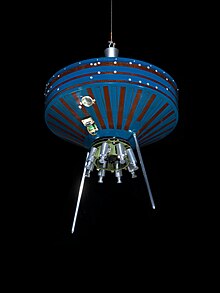Pioneer 0
| COSPAR ID | ABLE1 |
|---|---|
| Mission duration | 73.6 seconds[4] Failed to orbit |
| Apogee | 16 kilometers (9.9 mi)[2] |
| Spacecraft properties | |
| Manufacturer | Space Technology Laboratories[1][2] |
| Launch mass | 83.8 pounds (38.0 kg)[5] |
| Start of mission | |
| Launch date | 17 August 1958, 12:18 GMT LC-17A[2] |
| Instruments | |
Project Able-1 Probes (USAF) → | |
| Instruments | |
|---|---|
| TV camera : | Photograph the Moon |
| Magnetometer : | Interplanetary magnetic field |
| Micrometeoroid detectors : | Micrometeoroids |
Pioneer 0 (also known as Able 1) was a failed
Spacecraft design
The
The scientific instrument package had a mass of 11.3 kg (25 lb) and consisted of:
- An image scanning infrared television system of the Naval Ordnance Test Station (NOTS) design to study the Moon's surface, particularly the part normally unseen from Earth.[5]
- A diaphragm/microphone assembly to detect micrometeorites. A micrometeorite hitting the diaphragm would generate an acoustic pulse that would travel through the diaphragm to the microphone. The microphone contained a piezoelectrical crystal that rang at 100 kc under influence of the acoustic pulse. A bandpass amplifier would amplify the signal, so it could be detected.[5]
- A interplanetary magnetic field. At the time, it was not known whether the Moon had a magnetic field or not.[5]
The spacecraft was powered by
Launch and failure


Pioneer 0 was launched on Thor missile number 127 at 12:18:00 GMT on 17 August 1958 by the Air Force Ballistic Missile Division, only 4 minutes after the scheduled launch time.[4] It was destroyed by an explosion of the first stage of the Thor booster, 73.6 seconds after lift-off[4] at 15.2 km (9.4 mi) altitude, 16 km (10 mi) downrange over the Atlantic Ocean. The failure was suspected to be due to a turbopump bearing that came loose, causing the liquid oxygen pump to stop. The abrupt loss of thrust caused the Thor to lose attitude control and pitch downward, which caused the LOX tank to rupture from aerodynamic loads and resulting in complete destruction of the launch vehicle.[4] Erratic telemetry signals were received from the payload and upper stages for 123 seconds after the explosion, and the upper stages were tracked to impact in the ocean. The original plan was for the spacecraft to travel for 2.6 days to the Moon, at which time a TX-8-6 solid-propellant motor would fire to put it into a 29,000 km (18,000 mi) lunar orbit which was to nominally last for about two weeks. Air Force officials stated that they were not surprised at the failure, adding that "it would have been more of a shock had the mission succeeded."[citation needed] It was the only mission in the Project Able-1 Probes (USAF) entirely run by the Air Force Ballistic Missile Division, as subsequent missions were conducted by NASA.[1]
References
- ^ a b c d e f "Pioneer 0, 1, 2". Mission and Spacecraft Library. Jet Propulsion Laboratory, NASA. Archived from the original on 2009-01-31. Retrieved 2009-02-17.
- ^ a b c d e f g Wade, Mark (2008). "Pioneer 0-1-2". Encyclopedia Astronautica. Archived from the original on 2008-10-15. Retrieved 2009-02-17.
- ^ Waldron, Harry (Fall 2004). "The Air Force Ballistic Missile Division and the Pioneer Lunar Probes of 1958" (PDF). High Frontier the Journal for Space and Missile Professionals. 1 (2). United States Air Force Space Command: 10. Archived from the original (PDF) on November 17, 2016. Retrieved January 4, 2021.
- ^ a b c d e f 1958 NASA/USAF Space Probes (ABLE-1) Final Report: Volume 1. Summary (PDF) (Report). Space Technology Laboratories. 1959-02-18. Retrieved 2009-02-17.
- ^ a b c d e 1958 NASA/USAF Space Probe (ABLE-1) Final Report: Volume 2. Payload and Experiments (PDF) (Report). Space Technology Laboratories. 1959-02-18. Retrieved 2009-02-17.
- LCCN 2017059404. SP2018-4041.
- ^ Marcus, Gideon (2007-02-14). "Pioneering Space" (PDF). Quest. pp. 52–59. Retrieved 2009-02-17.
External links
- United States Space Program Progress 1958 discusses Pioneer 0 - 3 at YouTube
- Pioneers 0-2 documents at Space Technology Laboratories archive

